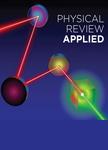版权所有:内蒙古大学图书馆 技术提供:维普资讯• 智图
内蒙古自治区呼和浩特市赛罕区大学西街235号 邮编: 010021

作者机构:Department of Electrical Engineering and Information Systems The University of Tokyo 7-3-1 Hongo Bunkyo-ku Tokyo 113-8656 Japan Center for Spintronics Research Network The University of Tokyo 7-3-1 Hongo Bunkyo-ku Tokyo 113-8656 Japan Institute of Engineering Innovation Graduate School of Engineering The University of Tokyo 7-3-1 Hongo Bunkyo-ku Tokyo 113-8656 Japan PRESTO JST 4-1-8 Honcho Kawaguchi Saitama 332-0012 Japan Department of Physics The University of Tokyo 7-3-1 Hongo Bunkyo-ku Tokyo 113-0033 Japan Materials Sciences Research Center Japan Atomic Energy Agency Sayo-gun Hyogo 679-5148 Japan Department of Applied Physics Tokyo University of Science Katsushika Tokyo 125-8585 Japan Quantum Matter Program Graduate School of Advanced Science and Engineering Hiroshima University Higashi-Hiroshima 739-8530 Japan Department of Applied Physics Waseda University Okubo Shinjuku Tokyo 169-8555 Japan
出 版 物:《Physical Review Applied》 (Phys. Rev. Appl.)
年 卷 期:2021年第15卷第6期
页 面:064019-064019页
核心收录:
基 金:Japan Science and Technology Agency, JST Spintronics Research Network of Japan Japan Atomic Energy Agency, JAEA, (2020A-E18, 2017B-E19) Japan Society for the Promotion of Science, JSPS, (18H03860) Ministry of Education, Culture, Sports, Science and Technology, MEXT, (JPMXP09A20AE0018, A-17-AE-0038) Precursory Research for Embryonic Science and Technology, PRESTO, (JPMJPR19LB, JPMJCR1777)
主 题:Electronic structure Ferromagnetism Magnetic anisotropy Metal-insulator transition Spintronics Transition metal oxides Photoemission spectroscopy X-ray magnetic circular dichroism
摘 要:A fundamental understanding of the interfacial magnetic properties in ferromagnetic heterostructures is essential for utilizing ferromagnetic materials for spintronic device applications. Here, we investigate the interfacial magnetic and electronic structures of epitaxial single-crystalline LaAlO3(LAO)/La0.6Sr0.4MnO3(LSMO)/Nb:SrTiO3(Nb:STO) heterostructures with varying LSMO layer thicknesses, in which the magnetic anisotropy strongly changes with the LSMO thickness due to the delicate balance between strains originating from both the Nb:STO and LAO layers, using x-ray magnetic circular dichroism and photoemission spectroscopy. We successfully detect the clear change of the magnetic behavior of the Mn ions concomitant with the thickness-dependent metal-insulator transition. Our results suggest that the double-exchange interaction induces ferromagnetism in the metallic LSMO film under tensile strain caused by the STO substrate, while the superexchange interaction determines the magnetic behavior in the insulating LSMO film under compressive strain originating from the top LAO layer. The change in strain, depending on LSMO layer thickness, is confirmed by scanning transmission electron microscopy. Based on those findings, the formation of a magnetic dead layer near the LAO/LSMO interface is attributed to competition between the superexchange interaction via Mn 3d3z2−r2 orbitals under compressive strain and the double-exchange interaction via the 3dx2−y2 orbitals. These findings provide key aspects of ferromagnetic oxide heterostructures for the development of spintronic device applications.